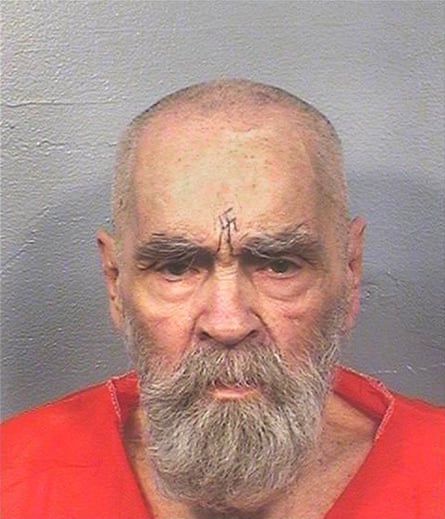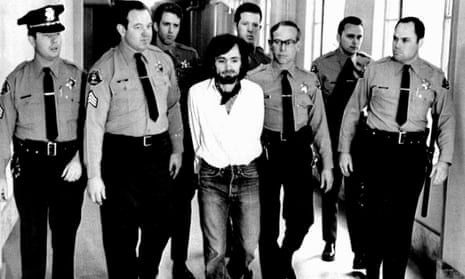Charles Manson, the pseudo-satanic sociopath behind a string of killings that shocked California out of its late 1960s cultural reverie, died on Sunday after almost a half century in prison.
The 83-year-old, who died of natural causes, had been serving multiple life sentences in state prison in Corcoran, California, for orchestrating the violence in 1969 that claimed the lives of Sharon Tate, the heavily pregnant wife of film director Roman Polanski, and six others.
While his death prompted the inevitable and renewed questioning around why his grim notoriety had been so enduring, Michele Hanisee, president of the Association of Deputy District Attorneys for Los Angeles County, said: “Today, Manson’s victims are the ones who should be remembered and mourned on the occasion of his death.”
She went on to quote the late Vincent Bugliosi, the prosecutor who put Manson behind bars, who had said: “Manson was an evil, sophisticated conman with twisted and warped moral values.”
Quick GuideA quick guide to Charles Manson
Show

Who was Charles Manson?
Charles Manson was one of the most notorious murderers of the 20th century. He led a cult known as the Manson Family in California, most of whom were disaffected young women. Some became killers under his messianic influence.
Murder from afar
Despite spending more than 40 years in prison for the murders of seven people in 1969, Manson did not carry out the killings. Instead he convinced members of his ‘family’ to murder. One of their victims was the actor Sharon Tate, who was married to Roman Polanski and was more than eight months' pregnant when she was killed.
Celebrity friends
By the time of his trial in 1971, Manson had spent half of his life in correctional institutions for various crimes. He became a singer-songwriter before the Tate murders and got a break in the music industry when he met Beach Boys' Dennis Wilson, who let him crash at his home.
Helter Skelter
It is believed that Manson intended using the murders to incite an apocalyptic race war he called Helter Skelter, taking the name from the Beatles song.
Notorious by name
The killings and the seven-month trial that followed were the subjects of fevered news coverage in the US. Manson occupied a dark, persistent place in American culture, inspiring music, T-shirts and half the stage name of musician Marilyn Manson.
As the leader of a cult known as the Manson Family, Manson had instructed his followers, made up mostly of disaffected young women, to carry out the killings. The brutality of the murders set Los Angeles on edge, and ended the sunny optimism of the 60s counterculture and its aspirations to a new society built on peace and love. Manson presented himself as a demonic force: at trial, he carved a Nazi swastika into his forehead.
The five received the death penalty but were spared when capital punishment was temporarily abolished following a ruling by the supreme court in 1972.
Manson and three female followers, Susan Atkins, Patricia Krenwinkel and Leslie Van Houten, were convicted of murder and conspiracy to murder. Another defendant, Charles “Tex” Watson, was convicted later.
Tate, the wife of Polanski, who was out of the country the night of her murder, was eight and a half months pregnant when Manson’s followers broke into her home in Los Angeles. They stabbed and shot Tate and her visitors, Jay Sebring, Voytek Frykowski, coffee heiress Abigail Folger and Steven Parent. The word “Pig” was written in blood on the front door. Tate, who had starred in The Valley of the Dolls, was stabbed 16 times, and an “X” was carved into her stomach.
The next night, his followers murdered couple Leno and Rosemary LaBianca.
Although the followers committed the murders, Manson had ordered them. At the LaBianca home, he tied up the couple before leaving others to carry out the killings.
After his death on Sunday night, Tate’s sister Debra told NBC: “One could say I’ve forgiven them, which is quite different than forgetting what they are capable of. It is for this reason I fight so hard to make sure that each of these individuals stays in prison until the end of their natural days.”
In the 2004 book Sharon Tate Recollection, Polanski wrote: “Even after so many years, I find myself unable to watch a spectacular sunset or visit a lovely old house or experience visual pleasure of any kind without instinctively telling myself how much she would have loved it all.”
Prosecutors at the time said Manson and his cult were trying to spark a race war that he believed was foretold in the Beatles song Helter Skelter, and hoped the Black Panthers would be blamed for the killings.
Before the murders, Manson spent most of his teens and 20s in and out of prison, and he later became a singer-songwriter. He got a break in the music industry when he met the Beach Boys drummer Dennis Wilson. The group later recorded Never Learn Not to Love, which Manson had written.

He became friends with the Byrds producer Terry Melcher (the son of Doris Day) and even recorded 13 folksy songs for an album that eventually was titled Lie: The Love and Terror Cult; it was released in March 1970 to help pay for his defense.
Manson had established himself as a would-be cult leader in the Haight-Ashbury district of San Francisco. He took a handful of followers, some of whom would later be convicted in the killings, to the old Spahn Movie Ranch north of LA and turned it into a hedonistic commune.
Van Houten, the youngest member of the original Manson Family, later said that Manson had used sex, LSD, Bible readings, repeated playing of the Beatles’ White Album and rambling lectures about triggering a revolution to brainwash her.
Van Houten, 68, was convicted of the killings of Leno and Rosemary LaBianca. She was recommended for parole in September but California’s governor, Jerry Brown, has yet to approve the recommendation. He rejected an earlier decision, concluding that Van Houten posed “an unreasonable danger to society if released from prison”.
In June, officials denied a parole request by Krenwinkel, the state’s longest-serving female prisoner, after her attorney said she had been abused by Manson or another person. She has been denied parole multiple times in the past.
Manson’s lawyer, Irving Kanarek, claimed his client was innocent during a 2014 interview with the Guardian. “No question he was legally innocent. And, more than that, he was actually innocent,” Kanarek said, arguing that there was no evidence connecting him to the case.
At a 2012 parole hearing, which was denied, Manson was quoted as having said to one of his prison psychologists: “I’m special. I’m not like the average inmate. I have spent my life in prison. I have put five people in the grave. I am a very dangerous man.”
According to the LA Times, Manson committed hundreds of rules violations while being held at the Corcoran state prison, including assault, repeated possession of a weapon and threatening staff. Officials said he has spat in guards’ faces, started fights, tried to cause a flood and set his mattress ablaze.
In 2014, Manson and Afton Elaine Burton, a 26-year-old Manson devotee, were granted a marriage license, but it expired before the two could marry. She had faithfully visited him in prison for seven years. Manson had been denied parole 12 times, with his next hearing set for 2027.
His death is unlikely to end interest in his crimes. Quentin Tarantino is believed to be preparing a film that uses the murders as a backdrop for its main plot, and an adaptation of Emma Cline’s bestselling 2016 novel, The Girls, is on the way.
Writer Joan Didion interviewed Linda Kasabian, the Manson family member who acted as a lookout in the Tate and LaBianca killings and later gave evidence at the trial, and described the atmosphere in Hollywood in an essay from her collection The White Album (1979).
“Everything was unmentionable but nothing was unimaginable…” Didion wrote. “A demented and seductive vortical tension was building in the community. The jitters were setting in. I recall a time when the dogs barked every night and the moon was always full.
“I remember that no one was surprised.”
Reached at home in Manhattan, Didion, 82, told the Guardian: “Manson’s legacy was never obvious to me. It wasn’t obvious when I went to talk with Linda Kasabian, and it isn’t obvious to me now. But I do find it easy to put him from my mind.”
In 2008, California officials ordered the search of a deserted ranch in Death Valley where Manson and his family briefly resided. The search turned up no evidence of human remains.
Manson may be gone but the persistence of his dark vision endures. “I am crime,” he proclaimed in a telephone call to the New York Post from prison in the mid-2000s.
